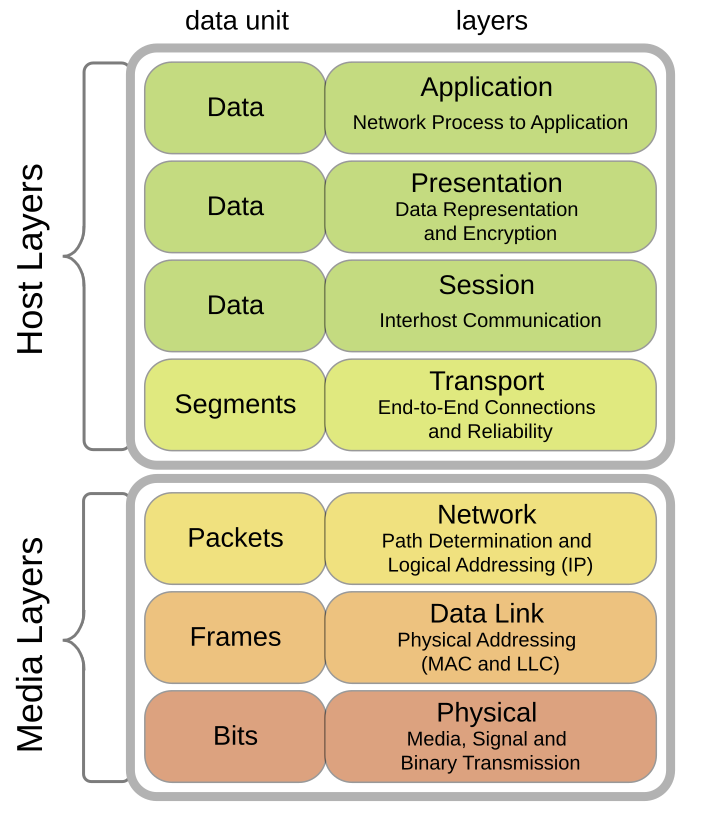OSI Model
Open Systems Interconnect Model
The OSI (Open Systems Interconnection) model is a conceptual framework that standardizes the functions of a telecommunication or networking system into seven distinct layers. It provides a structured approach to understanding and designing network protocols and interactions.
- Layer 7 – Application
- Layer 6 – Presentation
- Layer 5 – Session
- Layer 4 – Transport
- Layer 3 – Network
- Layer 2 – Data Link
- Layer 1 – Physical
Each layer serves a specific purpose in the process of transmitting data over a network.
Application
Application Layer (Layer 7)
The topmost layer is where the actual application or user interacts with the network. It provides various application services such as email, file transfer, and web browsing.
Protocols
HTTP, HTTPS, FTP, SMTP, POP3, IMAP, DNS
Algorithms
None (Application layer is primarily concerned with application-specific data and does not typically involve specific algorithms.)
Presentation
Presentation Layer (Layer 6)
This layer is responsible for data translation, encryption, and compression, ensuring that data sent by the application layer is presented correctly to the application on the receiving end. It deals with issues like character encoding and data format conversion.
Protocols
SSL/TLS (for secure communication)
Algorithms
Data compression algorithms, encryption/decryption algorithms (e.g., AES, DES)
Session
Session Layer (Layer 5)
The Session Layer establishes, maintains, and terminates connections between two devices, ensuring that data is synchronized and organized during the communication session. It can also handle tasks like session checkpointing and recovery.
Protocols
NetBIOS, RPC (Remote Procedure Call)
Algorithms
None (Session layer primarily deals with managing sessions and connections.)
Transport
Transport Layer (Layer 4)
The Transport Layer is responsible for end-to-end communication and ensures that data is reliably transmitted between two devices. It manages error detection, correction, and flow control.
Protocols
TCP (Transmission Control Protocol), UDP (User Datagram Protocol), SCTP (Stream Control Transmission Protocol)
Algorithms
Error checking and correction algorithms (e.g., checksums), flow control algorithms (e.g., sliding window), congestion control algorithms
Network
Network Layer (Layer 3)
This layer deals with routing, addressing, and forwarding packets of data. It establishes logical paths between source and destination nodes in a network.
Protocols
IP (Internet Protocol), ICMP (Internet Control Message Protocol), OSPF (Open Shortest Path First), BGP (Border Gateway Protocol), RIP (Routing Information Protocol)
Algorithms
Routing algorithms (e.g., Dijkstra’s algorithm), IP addressing and subnetting algorithms
Data Link Layer (Layer 2)
Data Link Layer (Layer 2)
The Data Link Layer is responsible for creating a reliable link between two directly connected nodes, ensuring data integrity and error detection.
Protocols
Ethernet, PPP (Point-to-Point Protocol), Wi-Fi (802.11), MAC (Media Access Control) addresses
Algorithms
Ethernet frame encoding/decoding, error detection and correction (e.g., CRC)
Physical
Physical Layer (Layer 1)
This layer deals with the physical medium and transmission of raw bits over a physical connection, such as cables, switches, and network interfaces. It defines characteristics like voltage levels, connectors, and data rates.
Protocols
Ethernet, Wi-Fi, DSL (Digital Subscriber Line), Fiber Optics
Algorithms
Modulation and demodulation (e.g., QAM, PSK), signal encoding, error handling
